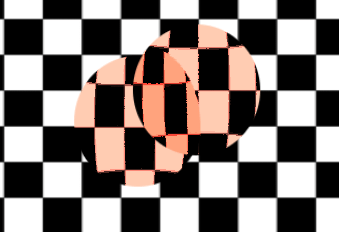Screen-reading shaders
The workaround is to make a copy of the screen, or a part of the screen, to a back-buffer and then read from it while drawing. Godot provides a few tools that make this process easy!
SCREEN_TEXTURE built-in texture
Godot has a special texture, (and DEPTH_TEXTURE for depth, in the case of 3D). It takes as argument the UV of the screen and returns a vec3 RGB with the color. A special built-in varying: SCREEN_UV can be used to obtain the UV for the current fragment. As a result, this simple canvas_item fragment shader:
results in an invisible object, because it just shows what lies behind.
The reason why textureLod must be used is because, when Godot copies back a chunk of the screen, it also does an efficient separatable gaussian blur to its mipmaps.
This allows for not only reading from the screen, but reading from it with different amounts of blur at no cost.
Note
SCREEN_TEXTURE can be used for many things. There is a special demo for Screen Space Shaders, that you can download to see and learn. One example is a simple shader to adjust brightness, contrast and saturation:
Behind the scenes
While this seems magical, it’s not. In 2D, the SCREEN_TEXTURE built-in, when first found in a node that is about to be drawn, does a full-screen copy to a back-buffer. Subsequent nodes that use it in shaders will not have the screen copied for them, because this ends up being inefficient. In 3D, the screen is copied after the opaque geometry pass, but before the transparent geometry pass, so transparent objects will not be captured in the SCREEN_TEXTURE.
As a result, in 2D, if shaders that use overlap, the second one will not use the result of the first one, resulting in unexpected visuals:
In the above image, the second sphere (top right) is using the same source for SCREEN_TEXTURE as the first one below, so the first one “disappears”, or is not visible.
In 2D, this can be corrected via the BackBufferCopy node, which can be instantiated between both spheres. BackBufferCopy can work by either specifying a screen region or the whole screen:
With correct back-buffer copying, the two spheres blend correctly:

In 3D, there is less flexibility to solve this particular issue because the SCREEN_TEXTURE is only captured once. Be careful when using SCREEN_TEXTURE in 3D as it won’t capture transparent objects and may capture some opaque objects that are in front of the object.
You can reproduce the back-buffer logic in 3D by creating a with a camera in the same position as your object, and then use the Viewport’s texture instead of SCREEN_TEXTURE.
So, to make it clearer, here’s how the backbuffer copying logic works in Godot:
- If a node uses the , the entire screen is copied to the back buffer before drawing that node. This only happens the first time; subsequent nodes do not trigger this.
- If a BackBufferCopy node was processed before the situation in the point above (even if
SCREEN_TEXTUREwas not used), the behavior described in the point above does not happen. In other words, automatic copying of the entire screen only happens ifSCREEN_TEXTUREis used in a node for the first time and no BackBufferCopy node (not disabled) was found before in tree-order.
DEPTH_TEXTURE
For 3D Shaders, it’s also possible to access the screen depth buffer. For this, the DEPTH_TEXTURE built-in is used. This texture is not linear; it must be converted via the inverse projection matrix.


